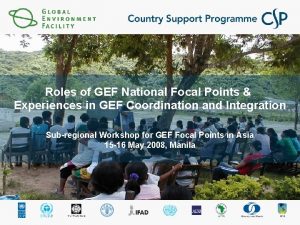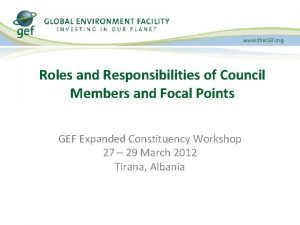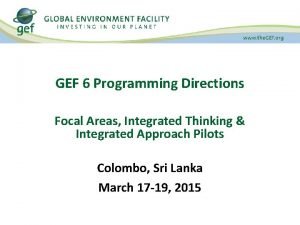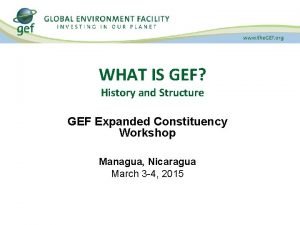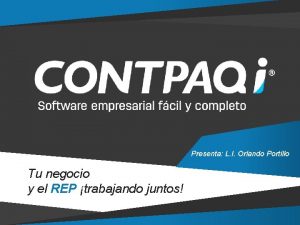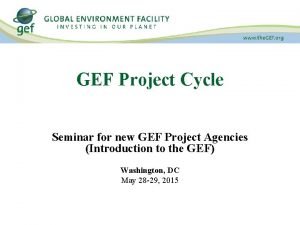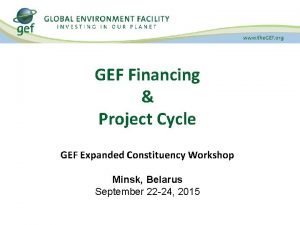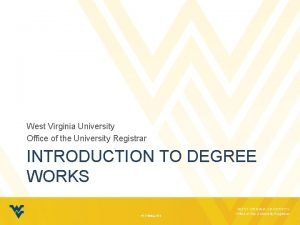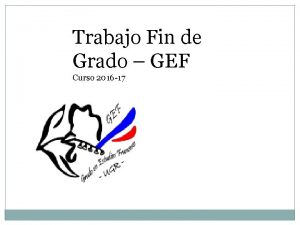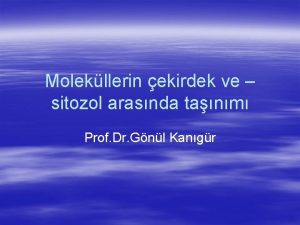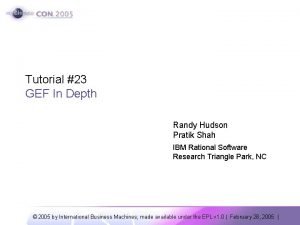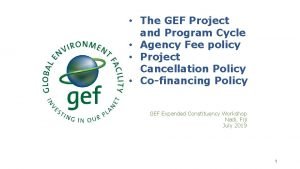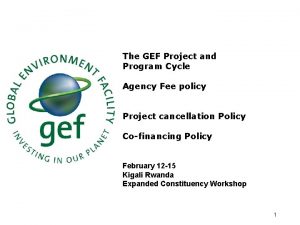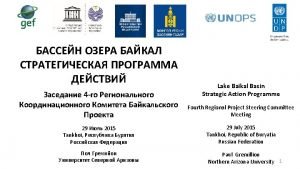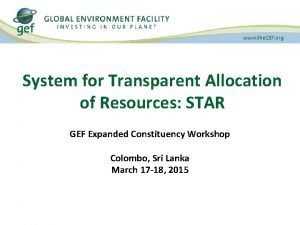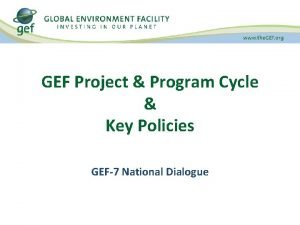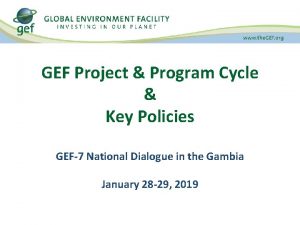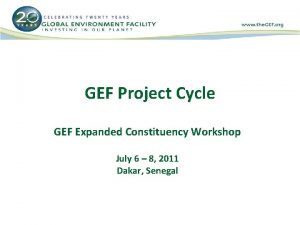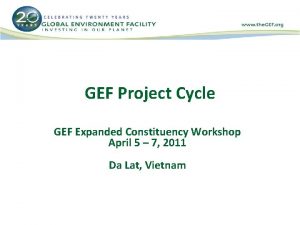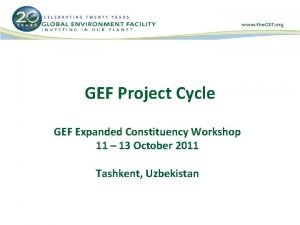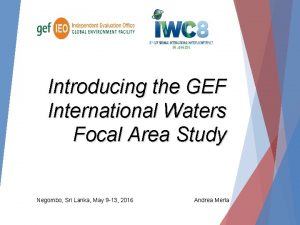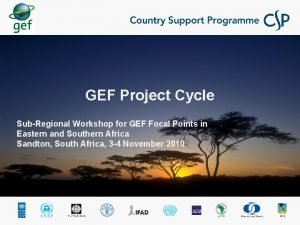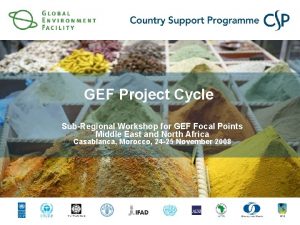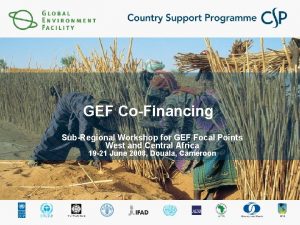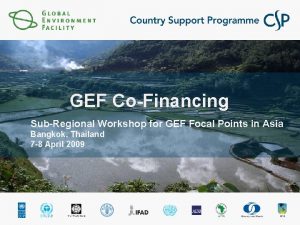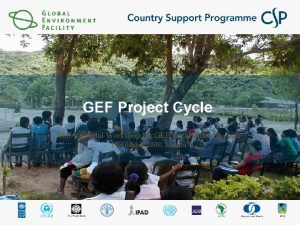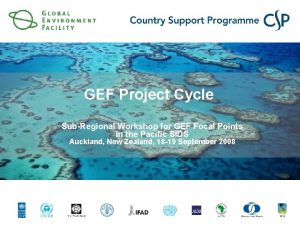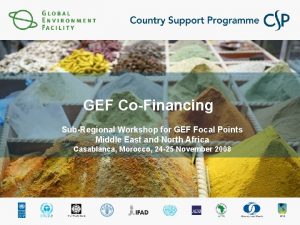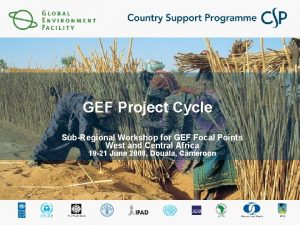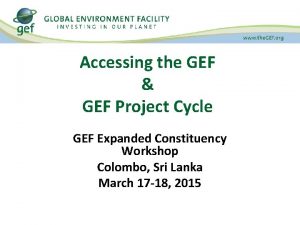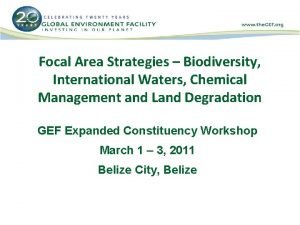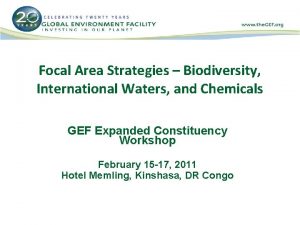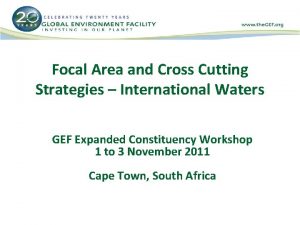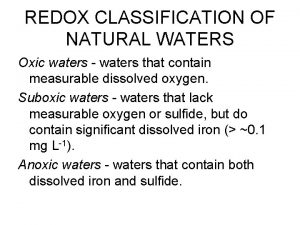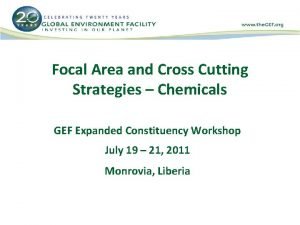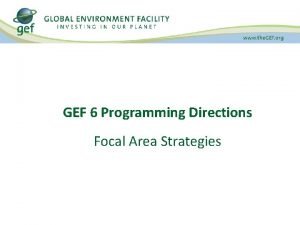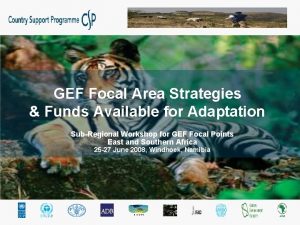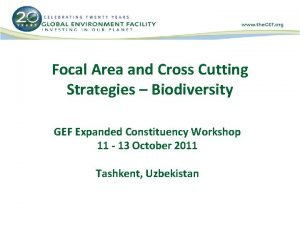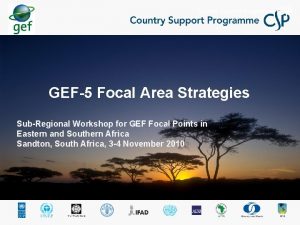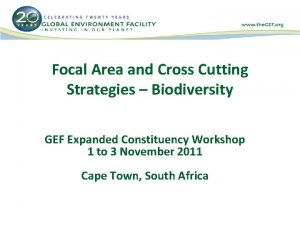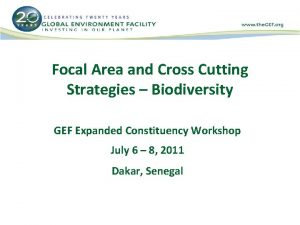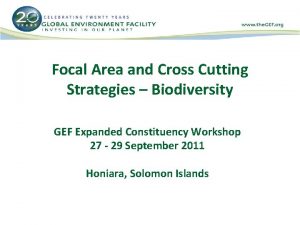GEF International Waters Focal Area International Waters IW
























- Slides: 24

GEF International Waters Focal Area International Waters (IW) includes transboundary river lake, and groundwater basins; also oceans, coasts, Large Marine Ecosystems and connected river basins

1995 GEF Operational Strategy. International Waters • 2 Long-term Goals for the IW focal area: -Collective, multi-state management of transboundary water systems -Implementation of the full range of technical, economic, financial, regulatory, and institutional reforms and investments contributing to sustainable use of those transboundary waters

GEF International Waters Portfolio of Approved Projects (FY 1992 -2009) *182 Projects with 172 Collaborating Countries *$1. 1 Billion in GEF Grants; $4. 8 Billion in Cofinancing

Emphasis for GEF 5 in IW will be Scaling Up On-the. Ground Operations Continuing Current Trend 4500, 0 Cumulative Trend of GEF Grants and Co-financing in International Waters 4214. 5 4000, 0 US$ in Million 3500, 0 3000, 0 2500, 0 2000, 0 1500, 0 1042. 7 1000, 0 209, 6 500, 0 167, 1 1991 -1996 1997 -2000 2001 -2004 2005 -2008 GEF Allocation Co-financing

GEF-5 Programming Document GEF Replenishment: Third Meeting October 14 -15, 2009 Paris, France

Draft GEF 5 International Waters Objectives $500 million Scenario Objective 1: Catalyze multi-state cooperation to balance conflicting water uses in transboundary surface/groundwater basins while considering climatic variability and change Objective 2: Catalyze multi-state cooperation to rebuild marine fisheries and reduce pollution of coasts and Large Marine Ecosystems (LMEs) while considering climatic variability and change Objective 3: Support foundational capacity building, portfolio learning, and targeted research needs for ecosystem-based, joint management of transboundary water systems $660 million Scenario Objective 4: Promote effective management of Marine Areas Beyond National Jurisdiction (ABNJ) directed at preventing fisheries depletion --joint with Biodiversity

International Waters Allocation • $500 million $1 billion co-financing • $660 million $1. 7 billion co-financing Objective 1: Freshwater System Outcomes Regional institutional frameworks for adaptive management; adoption/ implementation of reforms in 60% of States and limited demos in 50% of States in 8 -9 transboundary systems Regional institutional frameworks for adaptive management; adoption/ implementation of reforms in 65% of States and limited demos in 60% of States in 9 -10 transboundary systems Objective 2: Coastal and Marine System Outcomes Regional institutional frameworks for adaptive management; adoption/ implementation of reforms in 70% of States and limited demos in 50% of States for 8 -10 LMEs Regional institutional frameworks for adaptive management; adoption/ implementation of reforms in 75% of States and measureable demo investment results in at least 60% of States for 10 -11 LMEs with global policy impact Objective 3: Foundational Multi-state agreed actions on Capacity Building & Portfolio reforms/investments for 9 -10 new Learning Outcomes waterbodies Multi-state agreed actions on reforms/investments for 10 -11 new waterbodies; IW portfolio performance improved through KM/learning

Key Implications of Draft IW Strategy • New IW projects to incorporate considerations of climatic variability and change • New freshwater basin projects to incorporate both surface water and groundwater in true spirit of IWRM & floods/droughts/floodplain management • New Coastal and LME projects to incorporate ICM & consider sea level rise/flooding/reefs/fisheries/ blue carbon/blue forests(mangroves, kelp, seagrass, marshes) • GEF IW projects will be more costly with capacity building and foundational work on aquifers, IWRM, ICM, climatic variability, & legal frameworks • Results at community scale, gender issues, and experiencesharing/ learning will be stressed

Figure 6: Global Observed Temperatures Combined global land, air, and sea surface temperatures 1860 to August 1998 (relative to 1961– 1990 average) Source: The U. K. Meteorological Office. 1997. Climate Change and Its Impacts: A Global Perspective.

Climate Risks and Development: The “Poor Countries’ Danger” Six Climate Threats Top 12 Countries Most at Risk from Each Drought Flood Storm Low Income Coastal 1 m Coastal 5 m Agriculture High Income Middle Income Malawi Bangladesh Philippines All low-lying Island States Sudan Ethiopia China Bangladesh Vietnam Netherlands Senegal Zimbabwe India Madagascar Egypt Japan Zimbabwe India Cambodia Vietnam Tunisia Bangladesh Mali Mozambique Moldova Indonesia Philippines Zambia Niger Laos Mongolia Mauritania Egypt Morocco Mauritania Pakistan Haiti China Brazil Niger Eritrea Sri Lanka Samoa Mexico Venezuela India Sudan Thailand Tonga Myanmar Senegal Malawi Chad Vietnam China Bangladesh Fiji Algeria Kenya Benin Honduras Senegal Vietnam Ethiopia Iran Rwanda Fiji Libya Denmark Pakistan

It Will Get Worse Potential Impact on Agriculture — Projected Percentage Change in Agricultural Productivity in 2080 Note: Scenario: SRES A 2. Source: Cline 2007.

Mountain Water Systems Melting Creates Downstream Water Conflicts

Water Stress in Critical Regions will Increase Climate change can affect water availability & demand patterns and aggravate water stress.

Percentage Change in Runoff by 2050 • • Many of the major “food-bowls” of the world are projected to become significantly drier Globally there will be more precipitation Higher temperatures will tend to reduce run off A few important areas drier (Mediterranean, southern South America, northern Brazil, west and south Africa)


Temperature Increases in EAST CHINA SEA Large Marine Ecosystem Mean Annual SST and Annual Anomalies of SST IW SAG 4/10/07 - 22

• Yellow Sea LME

Startling Estimates of Nitrogen Export to Coasts Now Being Refined in a GEF-supported Project- GEF/UNEP/IOC-UNESCO

Global Decline in Fisheries-related Biodiversity in LMEs

Change in Catch Potential in 2030 (% relative to 2005) < (-50) (-31) – (-15) (-6) – 5 16 – 30 51 – 100

GEF Portfolio of Transboundary Groundwater Projects in Africa Protection of the North West Sahara Aquifer System (NWSAS) and related humid zones and ecosystems (UNEP/OSS) Formulation of an Action Programme for the Integrated Management of the Shared Nubian Aquifer (UNDP/IAEA) Developing Renewable Groundwater Resources in Arid Lands: a Pilot Case - the Eastern Desert of Egypt (UNDP) Managing Hydrogeological Risk in the Iullemeden Aquifer System (UNEP/OSS) Mainstreaming Groundwater Considerations into the Integrated Management of the Nile River Basin (UNDP/IAEA) Groundwater and Drought Management in the SADC region (World Bank)

Climate Change Adaptation: • GEF receives guidance from COP of UNFCCC • Supported further development of: – Least Developed Countries Fund (LDCF) – Special Climate Change Fund (SCCF) – Strategic Priority for Adaptation (SPA) • Funding: provided $270 m for adaptation through LDCF, SCCF, and SPA • GEFSEC Serves as Secretariat for Adaptation Fund Board (Kyoto Protocol)

GEF International Waters Ecosystem-Based Approach to Management of LMEs at Multiple Scales • Across LMEs in Region (Alternatives to Shrimp Trawling-FAO & Oceanic Fisheries/Tuna UNDP/FFA/WCPFC) • Large Marine Ecosystem Scale ( South China Sea LME-UNEP) • Coastal Municipality/Provincial ICM scale (Da Nang, Vietnam - UNDP PEMSEA) • River Basin Linkage Scale (GPA Mekong River Basin/delta - World Bank) • Local Community-based Demo Sites (Phu Quoc Fish Refugia Vietnam- UNEP)

GEF IWLEARN. net is being updated Please read the draft GEF 5 IW Strategy Let us know your thoughts: what do your countries need to cope with climatic variability? What can your project do to help? How can GEF help you?
 Gef roles
Gef roles Focal point
Focal point Gef focal areas
Gef focal areas Fragmentary ridge fingerprint
Fragmentary ridge fingerprint Line flower examples
Line flower examples Gef structure
Gef structure Https://mifactura.gef.mx
Https://mifactura.gef.mx Gef project cycle
Gef project cycle Gef project cycle
Gef project cycle Gef project cycle
Gef project cycle Wvu office of registrar
Wvu office of registrar Trabajar en gef
Trabajar en gef Sitozol
Sitozol If abc and gef are congruent by the asa criterion
If abc and gef are congruent by the asa criterion Gef tutorial
Gef tutorial Ceo approval
Ceo approval Ceo approval
Ceo approval Gef sap
Gef sap Gef star allocation
Gef star allocation E student gef
E student gef Gef project cycle
Gef project cycle Gef project cycle
Gef project cycle Gef project cycle
Gef project cycle Gef project cycle
Gef project cycle Gef
Gef
